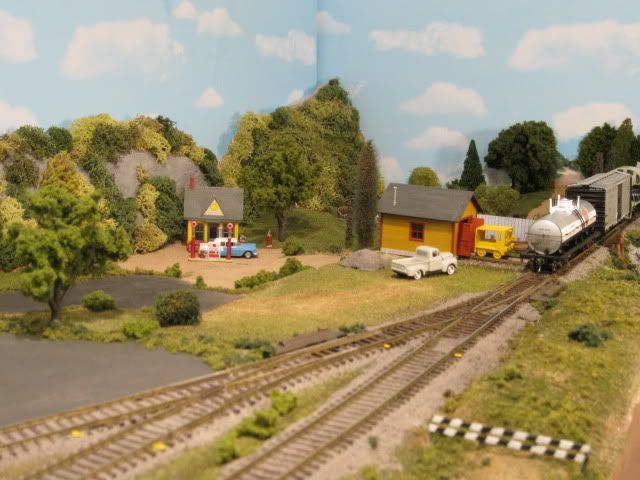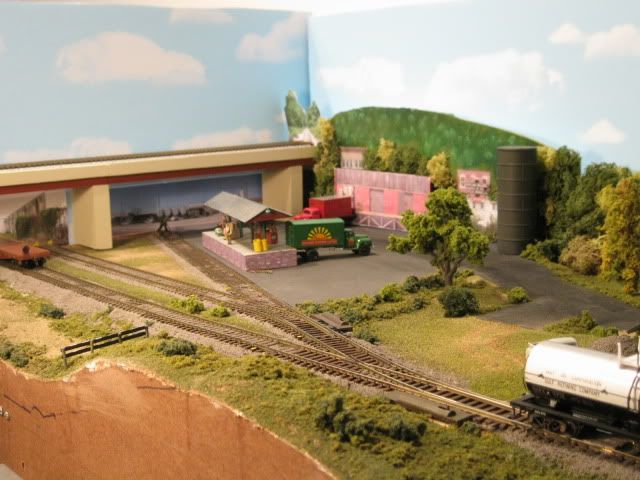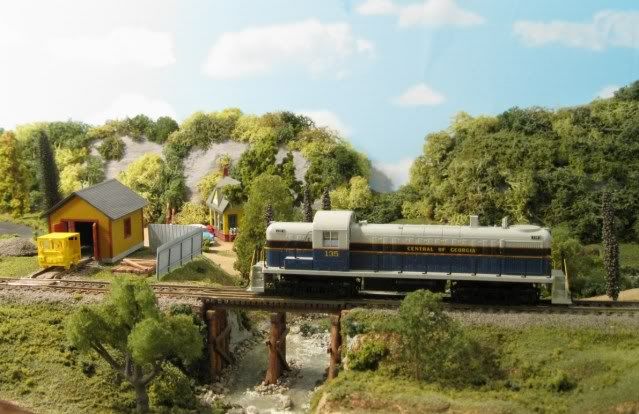Has anyone else incorporated (and runs) an “Inglenook Sidings” plan into their oval (or otherwise) layout? I am planning to do this on my first layout (under-construction) and would love to see pics of what others have come up with.
No Inglenooks but my current “layout” (if you can call it that, no pics) is a small oval with switching layout origins. Inspired by a trackplan from www.carendt.us it features a switchback spur inside the oval along with 2 single spurs on opposing ends. I like the idea of incorporating an Inglenook or Timesaver type segment into a layout so easy solo ops or friendly competitions are possible. It’s just fun sometimes. You’re not going to find much love on this site for such things however. According to current layout design dogma, those things are too “contrived” or “non-prototypical” for serious consideration. Fie. Do it if it pleases you I say. Besides, any small “yard” automatically qualifies as an Inglenook. Just pretend the lead track or main line has only so much capacity and play the game as if it did.
Lou
For a true Inglenook, you would also need to limit the length of your yard tracks - a true Inglenook is a switching game, with specific rules (including track lengths 1+3-5-3-3 cars), not just any collection of two short random spurs off a main.
A discussion of nooks from Adrian Wymann’s Small Layouts and Shunting Puzzles website: http://www.wymann.info/ShuntingPuzzles/sw-inglenook.html
A set of Inglenook layouts from Carl Arendt’s web site: http://www.carendt.com/microplans/pages/shelf/inglenook/index.html
Would I want to deliberately design in an inglenook on my layout? Nah. I would rather just add a couple of longer spurs and have some more varied fun. But to each his own.
Smile,
Stein
My point was that one needn’t design a switching puzzle into a layout on purpose. It can come about quite naturally. The example of a small “yard” was given because even for fairly long storage tracks, there’s always a limit. One could leave enough cars on the tracks to limit capacity to only the few being manipulated, define an artificially short lead to match and still be able to play the game or puzzle. A siding with 20 car capacity and 17 cars not participating in the game has on 3 “open” spots. While I wouldn’t design in too many “challenges” on purpose, I still think it’s a useful ploy to have at least one, especially in limited space layouts or as a device to maintain enthusiasm while the majority of the main is being constructed. Unless the tracks are set in concrete, things can be changed as tastes and opportunities develop. Besides, if the OP is like many of us, sooner rather than later he’ll end up with way too many cars for whatever layout he has. Might as well get used to tight quarters switching now.
Lou
thanks to the both of you for the ideas/feedback. What I like about the ideal of an inglenook in a layout is that regardless of whether it is contrived or not, it provides operational ideas for a beginner with no real knowledge of railroad functions. It provides this with ease. I also like the history of the whole thing. The Wright lines and all.
Err, no it doesn’t. The Timesaver and the Inglenook are switching games. “Operations” is a bit bigger concept than “cherry pick single cars from various spurs and sort them in a different order”.
If you are interested in realistic switching, then these links might give you some ideas:
Dave Hill’s O scale New Castle Industrial Railroad - simple track plan, but a good discussion of realistic switching: http://oscalewcor.blogspot.com/2010_10_01_archive.html
A discussion on cherry picking in yard on Byron Henderson’s web page: http://home.earthlink.net/~mrsvc/id20.html
A discussion from the Trains Magazine general forum on organizing cars in a local for switching industries: http://cs.trains.com/TRCCS/forums/p/184943/2022200.aspx
And of course - realistic switching is only a very tiny corner of operations - the biggest part of operations is running trains over the road, routing cars and things which cannot sensibly be simulated on a small switching layout.
Here is Richard Schumacher of the St. Louis (Gateway) chapter of the NMRA’s take on starting operations: http://www.gatewaynmra.org/designops.htm
By all means - enjoy your Inglenook - it is a fun game. But “operations” it ain’t.
Smile,
Stein
When I said operations, I meant in the sense that it gave a purpose (or something to do) with the model railroad.
The Inglenook pattern seems to happen quite often in the real world. There are may examples shown on various websites. Unliek the Timesaver, which IS purely just a game, there is some bit ot prototypical backing to an Inglenook setting. The rules of the ‘game’ limit the siding lengths to certain numbers of cars, but nothing says those three tracks have to be exactly parallel to one another in a purely contrived relationship. They don;t even have to be int he same order - the longer one can be in the middle,
–Randy
Yeah, I understood that.
To me, there is a difference between just moving some cars picked at random back and forth on some spurs, and moving those cars for a purpose - because they are loaded with something that needs to go somewhere to be delivered.
Your mileage obviously varies - that’s fine. Feel free to call moving random cars around on an Inglenook “operations”.
Grin,
Stein
I like Inglenooks a lot and have incorporated them into several previous layouts. On one, a 5-3-3 'Nook ran along the front edge of my benchwork , and the longest track left the layout at one end and connected to my staging tracks, thereby making it not only a fun switching exercise but my interchange yard as well.
My little freelanced shortline interchnged with the New York Central, and the interchange agreement between the two railroads stipulated that all cars delivered to the NYC must be pre-blocked to simplify switching in the Utica yards. The order in which the cars were blocked was determined by the random draw familiar to all 'Nook operators. So whenever I finished my pickups from local industries, it was necessary to play the Inglenook game and shuffle the outbound cars into order before the NYC local arrived.To me this seemed plausible and ‘railroady’.
I had a blast operating that layout, and although there’s no 'Nook on my currently-under-construction model railroad, I do a have a little 3-2-2 bookshelf switching layout upstairs in the den. In fact, I had an operating session just before writing this post.
Firebirds, thanks for that post. I like the idea of the inglenook setting the order for the cars to be switched over to the NYC. I am kinda heading in that sort of direction with my own layout… and it might just be the NYC that picks them up. Interesting coincidence.
I think Inglenook and Timesaver style track arrangements are (or were) a lot more common than we would like to think. When you consider these are “schematics” of track arrangments that covered whole blocks, you can see the similarity. Just within a few miles of where I grew up, I can point to several track arrangements (that existed until about 80s) that if I modeled them everyone would tell me are not prototypic. Heck even the town I’m in today had a couple of businesses that were still rail served within the last ten years where the building was almost smaller than the boxcar serving it.
For operations, if we can forget about the “game” for a minute, the Inglenook or Timesaver can represent, in schematic form, an industrial district served from somewhere else. That somewhere else can be as simple as a visible staging track where the train starts from, does it’s work, and ends up at. At some level all of model railroad operations is a game. It is only the specific rules that separate the levels of the game.
Couldn’t agree more, jmb. The prototype usually shown as an example of the Inglenook style of spurs/sidings/yard is over in Cornwall, in the west of England. But a couple of years ago on Carl Arendt’s site there was a post from an engineer on the Central Connecticut. He showed a picture of the sidings at a trash plant (if memory serves) in East Hartford, Connecticut. It was an absolutely perfect Inglenook–and he gets to switch it with 12"-scale freight cars…
And of course, just about any tank town in the Midwest with spurs radiating off a passing siding looks like some variation of a Timesaver–John Allen was perceptive as well as imaginative when he designed that one, since he obviously recognized what a common trackage arrangement it represented.
One final note–very happy to hear from hobo that his new layout may well interchange with the NYC. Since I see your avatar is a pic of the McGinnis Boston & Maine herald, thought I’d mention that my new layout will probably be based on the B&M in “Our Town”, Thornton Wilder’s fictitious town of Grover’s Corners, New Hampshire–and if I have room, the staging tracks will form a 3-2-2 'Nook!
Best to all,
Paul
(firebirds30)
These are sidings at Giles Chemical in Waynesville, NC which are an inglenook arrangement and easily adaptable to a model railroad or as a stand-alone micro layout

Ray
It seems to me that quite a few people confuse track plan fragments having a three-tined fork track schematic with an Inglenook.
Having two single ended trailing spurs off a main is perfectly normal. As is having two single ended facing spurs off the end of a line, where the long stem points back towards the rest of the line.
What makes the Inglenook a puzzle more than a realistic operation is the limited length of all spurs and the switching lead.
Here is an illustration of an inglenook game (from Adrian Wymann’s excellent web page http://www.wymann.info/ShuntingPuzzles/Inglenook/inglenook-trackplan.html)
The point of the game is to pick five out of eight cars and sort them into some order decided in advance (by drawing cards or whatever). It takes quite a bit of extra jockeying around to get the 5 cars into order using the three short spurs, since your switching lead is so short and the spurs are so short.
By all means - play the inglenook game. It is a fun little game in itself. But severely limiting the switching lead length and spur length does not necessarily add all that much realism to the game.
You can get a lot more realistic play value from the same type of three-tined track schematic by
The information you posted is informative and correct but I am not confused. I understand the concept of an Inglenook switching puzzle, as I’m sure others following this thread do. In fact I have built a 2 x 4 ft 3-2-2 Inglenook layout myself.



What I wrote was that the spurs in question are an, “Inglenook arrangement,” that is they are, in fact, a three tined fork arrangement. But search as we may I doubt that anyone will find an actual prototype of an Inglenook switching puzzle, 5-5-3 or 3-3-2 spur car capacity. What we have to do as model railroaders is adapt track arrangements, etc. that we find in the real world to our limited spaces, mo
Lemme see - mainline continuing through the scene. Runaround to the west. Three single ended spurs off the main between Miller Street and Depot Street, two on the north side, one on the south sid.
This is best modeled as a three tined fork?
How about a continous main with two short spurs off on the backdop side of the main and one longer spur off the main on the aisle side of the main?
How about a four tined fork, with the main being cut short at Depot Street?
How about the main being cut off at Depot Street with the runaround transplanted eastwards, so it runs parallel to main on the south side, parallel to the two spurs north of the main, with the spur originally on the south side of the main now branching off the south end of the runaround?
Lot of ways to model this area. Here are some possible plans for two scenes roughly based on this area (I’ve used some modeling license to make industries a little interesting to switch):
H0 scale shelf layout - 6 x 1 foot, can be built as one 4x1 foot and one 2x1 foot section:


Btw - good looking Inglenook you built.
Smile,
Stein
If you are just counting any stub ended tracks breaking off a main track as an “Inglenook” then every spur track is an “Inglenook”
I agree with Stein that an Inglenook is a specific concept (which I will confess I don’t really understand).
I have a branch on my layout that probably could be considered an Inglenook, but it was not concieved that way, its just a branch that terminates in 3 spurs, 2 belonging to EI Dupont and one for a flour mill. The local will have to shove cars down the branch and then switch the various industries as required. There would be very few cars, if any that would move between the spurs. It would mostly be inbound cars swapped for outbound cars.
I was just making an innocent contribution to this thread and for that I get a condesending, “some people seem confused,” and an, “It’s either my way or the highway,” attitude. An Inglenook is not a matter of objective truth. There is not a spiritural, eternal absolute authority behind it that must be obeyed. So what if the prototype trackplan you found on Google Maps or whatever had other sidings, a through mainline and a runaround half a mile away. That’s not the point; I wouldn’t model those in an Inglenook trackplan To repe
Stein’s got it right–the limitation on the siding lengths–and especially on the length of the headshunt, or yard lead, is what makes it an ‘Inglenook’. And for me at least, those limitations are what make the game fun.
For a different sort of fun, take a look at the Brea Industrial Lead on the UP in southern California (again, I’m indebted to Carl Arendt’s superb micro-layout site for tipping me off to this prototype). The end-of-track includes a plastics plant which receives two covered hoppers every time they switch the branch, an unused spur (which I’d reactivate if I built this LDE) and a lead track–actually the main–which was cut off short past the plastics plant switch, by abandonment of the branch beyond this point. It ends just short of a former road crossing and resembles the ‘spurs off main’ sketch in Stein’s very detailed post.
This looks like it would be waaayyy too much fun to incorporate at the end of a branch. I’ve sketched it, and if the truncated ‘yard lead’ will accommodate a Genset locomotive and a couple of four-bay hoppers it would be a blast to switch. The reactivated spur off the main could be a bottling plant, with spots for tank cars and one unloading door for boxcars.
Noted layout designer Lance Mindheim really puts it well in his books–he states that the number one design consideration when starting a layout is what will bring you the maximum enjoyment. Fortunately, we have a lot of choices and means for building an enjoyable layout.
Best to all,
Paul
(firebirds30)